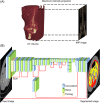Detection of sarcopenic obesity and prediction of long-term survival in patients with gastric cancer using preoperative computed tomography and machine learning
- PMID: 34490899
- PMCID: PMC9290491
- DOI: 10.1002/jso.26668
Detection of sarcopenic obesity and prediction of long-term survival in patients with gastric cancer using preoperative computed tomography and machine learning
Abstract
Background: Previous studies evaluating the prognostic value of computed tomography (CT)-derived body composition data have included few patients. Thus, we assessed the prevalence and prognostic value of sarcopenic obesity in a large population of gastric cancer patients using preoperative CT, as nutritional status is a predictor of long-term survival after gastric cancer surgery.
Methods: Preoperative CT images were analyzed for 840 gastric cancer patients who underwent gastrectomy between March 2009 and June 2018. Machine learning algorithms were used to automatically detect the third lumbar (L3) vertebral level and segment the body composition. Visceral fat area and skeletal muscle index at L3 were determined and used to classify patients into obesity, sarcopenia, or sarcopenic obesity groups.
Results: Out of 840 patients (mean age = 60.4 years; 526 [62.6%] men), 534 (63.5%) had visceral obesity, 119 (14.2%) had sarcopenia, and 48 (5.7%) patients had sarcopenic obesity. Patients with sarcopenic obesity had a poorer prognosis than those without sarcopenia (hazard ratio [HR] = 3.325; 95% confidence interval [CI] = 1.698-6.508). Multivariate analysis identified sarcopenic obesity as an independent risk factor for increased mortality (HR = 2.608; 95% CI = 1.313-5.179). Other risk factors were greater extent of gastrectomy (HR = 1.928; 95% CI = 1.260-2.950), lower prognostic nutritional index (HR = 0.934; 95% CI = 0.901-0.969), higher neutrophil count (HR = 1.101; 95% CI = 1.031-1.176), lymph node metastasis (HR = 6.291; 95% CI = 3.498-11.314), and R1/2 resection (HR = 4.817; 95% CI = 1.518-9.179).
Conclusion: Body composition analysis automated by machine learning predicted long-term survival in patients with gastric cancer.
Keywords: body mass index; gastric cancer; machine learning; nutrition process; sarcopenic obesity; survival.
© 2021 The Authors. Journal of Surgical Oncology published by Wiley Periodicals LLC.
Conflict of interest statement
The authors declare that there are no conflict of interests.
Figures




Similar articles
-
Is Sarcopenic Obesity an Indicator of Poor Prognosis in Gastric Cancer Surgery? A Cohort Study in a Western Population.J Gastrointest Surg. 2021 Jun;25(6):1388-1403. doi: 10.1007/s11605-020-04716-1. Epub 2020 Jul 13. J Gastrointest Surg. 2021. PMID: 32661833
-
Body composition analysis using CT at three aspects of the lumbar third vertebra and its impact on the diagnosis of sarcopenia.World J Surg Oncol. 2025 Feb 26;23(1):64. doi: 10.1186/s12957-024-03634-9. World J Surg Oncol. 2025. PMID: 40012042 Free PMC article.
-
Sarcopenia is an Independent Predictor of Severe Postoperative Complications and Long-Term Survival After Radical Gastrectomy for Gastric Cancer: Analysis from a Large-Scale Cohort.Medicine (Baltimore). 2016 Mar;95(13):e3164. doi: 10.1097/MD.0000000000003164. Medicine (Baltimore). 2016. PMID: 27043677 Free PMC article.
-
Muscle mass, assessed at diagnosis by L3-CT scan as a prognostic marker of clinical outcomes in patients with gastric cancer: A systematic review and meta-analysis.Clin Nutr. 2020 Jul;39(7):2045-2054. doi: 10.1016/j.clnu.2019.10.021. Epub 2019 Nov 1. Clin Nutr. 2020. PMID: 31718876
-
Sarcopenic Obesity and its Prognostic Impact on Urological Cancers: A Systematic Review.J Urol. 2021 Oct;206(4):854-865. doi: 10.1097/JU.0000000000001873. Epub 2021 May 25. J Urol. 2021. PMID: 34032495
Cited by
-
The Value of Artificial Intelligence-Assisted Imaging in Identifying Diagnostic Markers of Sarcopenia in Patients with Cancer.Dis Markers. 2022 Mar 29;2022:1819841. doi: 10.1155/2022/1819841. eCollection 2022. Dis Markers. 2022. PMID: 35392497 Free PMC article. Review.
-
The role of sarcopenic obesity for the prediction of prognosis of patients with gastrointestinal cancer.Cancer Med. 2024 Jul;13(13):e7452. doi: 10.1002/cam4.7452. Cancer Med. 2024. PMID: 38953401 Free PMC article.
-
Prognostic role of pretreatment skeletal muscle index in gastric cancer patients: A meta-analysis.Pathol Oncol Res. 2023 Apr 24;29:1611055. doi: 10.3389/pore.2023.1611055. eCollection 2023. Pathol Oncol Res. 2023. PMID: 37168049 Free PMC article.
-
Sarcopenic obesity and therapeutic outcomes in gastrointestinal surgical oncology: A meta-analysis.Front Nutr. 2022 Jul 22;9:921817. doi: 10.3389/fnut.2022.921817. eCollection 2022. Front Nutr. 2022. PMID: 35938099 Free PMC article.
-
Impact of sarcopenic obesity on post-hepatectomy bile leakage for hepatocellular carcinoma.PLoS One. 2023 Oct 5;18(10):e0286353. doi: 10.1371/journal.pone.0286353. eCollection 2023. PLoS One. 2023. PMID: 37796798 Free PMC article.
References
-
- Amin MB, Edge S, Greene F, Byrd DR, Brookland RK, MK W. AJCC Cancer Staging Manual. 8th ed. 2‐New York: Springer International Publishing; 2017.
-
- Kiuchi J, Komatsu S, Kosuga T, et al. Long‐term postoperative nutritional status affects prognosis even after infectious complications in gastric cancer. Anticancer Res. 2018;38(5):3133‐3138. - PubMed
-
- Minami Y, Kawai M, Fujiya T, et al. Family history, body mass index and survival in Japanese patients with stomach cancer: a prospective study. Int J Cancer. 2015;136(2):411‐424. - PubMed

